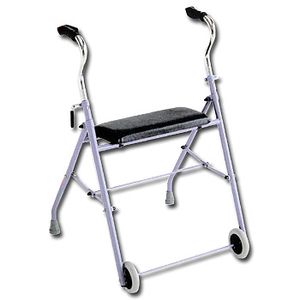Walkers
Original Editor - The Open Physio project.
Top Contributors - Lucinda hampton, Lauren Lopez, Admin, Jess Bell, Kim Jackson, Jeremy Bryan, Rachael Lowe, Larisa Hoffman, Abbey Wright, Ammar Suhail, WikiSysop, Redisha Jakibanjar, Robin Tacchetti and Naomi O'Reilly
Introduction[edit | edit source]
A walker is a walking aid that has four points of contact with the ground and usually has three sides with the side closest to the patient being open. It provides a wider base of support than a walking stick and so is used more to stabilise patients with poor balance.
Types of Walkers [edit | edit source]
Many walkers exists on the market and a physiotherapist is well placed to be instrumental in choosing the correct walker for the differing needs of clients.
- Wheels on all four legs, with or without brakes. Many variations exist in the designs of the walkers eg hards seat, material seats, carry baskets/bags, push down brakes, grip on brakes, large wheels for outdoors, small wheels for indoors, carbon fibre light weight for easy lifting into cars. All variations should be taken into account so the most suitable one is chosen for a particular persons needs. A large sturdy forearm support 4 wheels walker also exists for those needy extra stability.
- Two front legs with two rear casters
- Two front legs and two rear wheels with brakes which operate on downward pressure on the wheels
- "Square" wheels
- Ability to be folded, which makes travelling with the frame easier
- Trays, seats and baskets may be attached
- Other modifications such as a light that projects a red line on the ground in order to guide step length in individuals with Parkinsons
- High or gutter frames for users who need more support. The user weight bears through their forearms on gutter-shaped supports, with the elbows flexed to approximately 90 degrees.
- Pulpit frames where the user also weight bears through their forearms and hands on a padded U shaped support, similar to leaning on a pulpit.
Prescription[edit | edit source]
There is no one walker that should be used[2]. Walker choice is dependent on what activities the user will use it for, where the walker will be used, how much support the user requires and the user's confidence with a walker.
Walkers should be adjustable in height, which is measured in the same way as one would measure for a walking stick[2]. Shoes should be taken into account during prescription as shoe height can significantly affect walker use[2].
Factors to take into account when prescribing a walking frame[2]:
- Height of the frame
- Weight of the frame when user propels and manoeuvres it
- Base area
- Manoeuvrability including wheel design e.g. fixed versus swivel
- Wheel placement
- Hand grip design
- Arm support design
- Folding versus unfolding
- Attachments e.g. trays and seats
Usage[edit | edit source]
Users should have a smooth gait pattern that is unimpeded by the frame. There should be adequate space for step placement.
Users should never attempt to use a frame, by pulling on it, to help them sit or stand.
A frame with four legs and a wide base, known as a Zimmer frame is used in the following way if weight-bearing on both legs.The user:
- Picks it up
- Moves it forwards
- Places it in front of them
- Leans on the frame, taking weight through the upper limbs
- Walks into it (the patient should be encouraged to take two small, even steps to avoid a disordered gait pattern)
A 4 wheeled walker
- Make sure walker is completely opened and hinges locked
- Keep close to the frame at all times, near the back wheels
- For downhill ramp use gently squeeze on brakes at all times
- Ensure that brakes are locked before sitting on the seat of frame, with frame on level ground, preferably with wall or fence behind.[3]
Maintenance[edit | edit source]
Brakes should be checked regularly to ensure they are working correctly. Wheels should be checked regularly and when the user reports tracking issues, e.g. frame pulling to one side. Wheels should also be checked as sometimes hard and repeated braking can distort the shape of the wheel making it lose its roundness.
The height of the frame should also be checked periodically to ensure it is the optimal height for the user's posture. This is especially important if the user is undergoing rehabilitation and changes in their balance, strength and posture are expected or observed on assessment.
References[edit | edit source]
- ↑ Reviews vid. Best walkers 2018-best rollator walkers with a seat. Available from: https://www.youtube.com/watch?v=azig88E770k&feature=youtu.be [last accessed 16/2/2019]
- ↑ 2.0 2.1 2.2 2.3 Hall J, Clarke AK, Harrison R. Guide Lines for Prescription of Walking Frames. Physiotherapy. 1990; 76 (2): 118-120.
- ↑ Government of South Australia. Department for communities and social services. January 2013. Available from https://www.des.sa.gov.au/_data/assets/word_doc/0011/19595/4-wheeled-walkers-fact-sheet.doc Last accessed 17/2/2019







